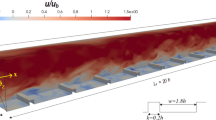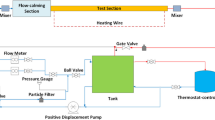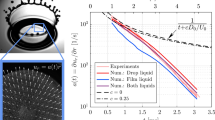Abstract
Low-temperature particle coating requires supersonic flow. The characteristics of this supersonic flow are investigated using a nonlinear turbulence model. The low-temperature, supersonic particle deposition technique is valuable because its rapid and dense coating minimizes thermal damage to both particles and substrate. It has excellent potential for industrial production of low-cost thin films. Stagnation pressures and temperatures of the supersonic nozzle range from 4 < P o < 45 bar and 300 < T o < 1500 K, respectively. The exit Mach number, M e, and velocity, V e, range from 0.6 to 3.5 and 200 to 1400 m/s, respectively. The effects of stagnation pressure (P o) and stagnation temperature (T o) on supersonic flow impinging upon a substrate are described. In other words, the energy loss through shockwaves and shear interactions between the streaming jet and surrounding gas are quantified as functions of P o and T o. P o is decreased because of friction (loss ranges from 40 to 60%) while T o is nearly conserved. To realize the nozzle exit condition of P e = P amb, we demonstrate that P o should be adjusted rather than T o, as T o has little effect on exit pressures. On the other hand, T o is more influential than P o for varying the exit velocity. Various nozzle geometries yielding different flow characteristics, and hence, different operating conditions and coating performances are investigated. The corresponding supersonic flows for three types of nozzles (under-, correctly , and over-expanded) are simulated, and their correctly expanded (or shock-free) operating conditions are identified. Diamond shock structures induced by the pressure imbalance between the exiting gas and the surrounding atmosphere are captured.













Similar content being viewed by others
References
R.C. Dykhuizen, M.F. Smith, D.L. Gilmorew, R.A. Neiser, X. Jiang, and S. Sampath, Impact of High Velocity Cold Spray Particles, J. Therm. Spray Tech., 1999, 8(4), p 559-564
A.P. Alkhimov, S.V. Klinkov, V.F. Kosarev, and A.N. Papyrin, Gas-Dynamic Spraying Study of a Plane Supersonic Two-Phase Jet, J. Appl. Mech. Tech. Phys., 2007, 38(2), p 324-330
D.L. Gilmore, R.C. Dykhuizen, R.A. Neiser, M.F. Smith, and T.J. Roemer, Particle Velocity and Deposition Efficiency in the Cold Spray Process, J. Therm. Spray Tech., 1999, 8(4), p 576-582
T.H. Van Steenkiste, J.R. Smith, and R.E. Teets, Aluminum Coatings via Kinetic Spray with Relatively Large Powder Particles, Surf. Coat. Technol., 2002, 154(2-3), p 237-252
J.A. Hearley, J.A. Little, and A.J. Sturgeon, The Effect of Spray Parameters on the Properties of High Velocity Oxy-Fuel NiAl Intermetallic Coatings, Surf. Coat. Technol., 2000, 123, p 210-218
L. Ajdelsztajn, B. Jodoin, G.E. Kim, and J.M. Schoenung, Cold Spray Deposition of Nanocrystalline Aluminum Alloys, Metall. Mater. Trans. A, 2005, 36A, p 657-666
J. Akedo, Room Temperature Impact Consolidation (RTIC) of Fine Ceramic Powder by Aerosol Deposition Method and Applications to Microdevices, J. Therm. Spray Tech., 2008, 17(2), p 181-198
B. Jodoin, Cold Spray Nozzle Mach Number Limitation, J. Therm. Spray Tech., 2002, 11(4), p 496-507
A.P. Alkhimov, S.V. Klkinkov, V.F. Kosarev, and A.N. Papyrin, Gas-Dynamic Spraying Study of a Plane Supersonic Two-Phase Jet, J. Appl. Mech. Technol. Phys., 1997, 38(2), p 324-330
A.P. Alkhimov, V.F. Kosarev, and A.N. Papyrin, Method of Cold Gas Dynamic Spraying, Sov. Phys. Dokl., 1990, 35(12), p 1047-1049
H. Assadi, F. Gartner, T. Stoltenhoff, and H. Kreye, Bonding Mechanism in Cold Gas Spraying, Acta Mater., 2003, 51, p 4379-4394
J. Vlcek, H. Huber, H. Voggenreiter, A. Fischer, E. Lugscheider, and H. Hallen, Kinetic Powder Compaction Applying the Cold Spray Process A Study on Parameters, ITSC Proc., 2001, p 417-422
C.J. Li and W.Y. Li, Deposition Characteristics of Titanium Coating in Cold Spraying, Surf. Coat. Technol., 2003, 167(2-3), p 278-283
R.C. Dykhuizen and R.A. Neiser, ITSC Proc., 2003, p 19-26
W.Y. Li and C.J. Li, Optimal Design of a Novel Cold Spray Gun Nozzle at a Limited Space, J. Therm. Spray Tech., 2005, 14(3), p 391-396
B. Samareh and A. Dolatabadi, A Three-Dimensional Analysis of the Cold Spray. Process: The Effects of Substrate Location and Shape, J. Therm. Spray Tech., 2007, 16(5-6), p 634-642
H. Takana, K. Ogawa, T. Shoji, and H. Nishiyama, Computational Simulation of Cold Spray Process Assisted by Electrostatic Force, Powder Technol., 2008, 185(116-123), p 116-123
T. Schmidt, F. Gartner, H. Assadi, and H. Kreye, Development of a Generalized Parameter Window For Cold Spray Deposition, Acta Mater., 2006, 54, p 729-742
J. Akedo, Aerosol Deposition of Ceramic Thick Films at Room Temperature: Densification Mechanism of Ceramic Layers, J. Am. Ceram. Soc., 2006, 89(6), p 1834-1839
F.F. Grinstein, Vortex Dynamics and Entrainment in Rectangular Free Jets, J. Fluid Mech., 2001, 437, p 69-101
M.T. Landahl, Wave Mechanics of Breakdown, J. Fluid Mech., 1972, 56, p 775-802
T. Herbert, Secondary Instability of Boundary Layers, Annu. Rev. Fluid Mech., 1988, 20, p 487-526
B.J. Bayly, S.A. Orszag, and T. Herbert, Instability Mechanisms in Shear-Flow Transition, Annu. Rev. Fluid Mech., 1988, 20, p 359-391
K. Itoh, Y. Nakamura, and Y. Kukita, Free-Surface Shear Layer Instabilities on a High-Speed Liquid Jet, Fusion Technol., 2000, 37, p 74-88
F.U.s. Guide, Fluent User’s Guide, 2008
W.Y. Li, C.-J. Liu, C.X. Wang, and H.S. Bang, Measurement and Numerical Simulation of Particle Velocity in Cold Spraying, J. Therm. Spray Tech., 2006, 15(4), p 559-562
V.I. Zapryagaev, A.N. Kudryavsev, A.V. Lokotok, A.V. Solotchin, A.A. Pavlov, and A. Hadjadj, An Experimental and Numerical Study of a Supersonic-Jet-Shock-Wave Structure, Proceedings of the XI International Conference on the Methods of Aerophysical Research, Vol 2, 2002, p 187-191
N.J. Dam, M. Rodenburg, R.A.L. Tolboom, G.G.M. Stoffels, P.M. Huisman-Kleinherenbrink, and J.J. ter Meulen, Imaging of an Underexpanded Nozzle Flow by UV Laser Rayleigh Scattering, Exp. Fluids, 1998, 24(2), p 93-101
J.D. Anderson and J. David, Computational Fluid Dynamics, McGraw-Hill, 1995
J.J. Park, M.W. Lee, S.S. Yoon, H.Y. Kim, S.C. James, S.D. Heister, S. Chandra, W.H. Yoon, D.S. Park, and J.H. Ryu, Supersonic Nozzle Flow Simulations for Particle Coating Applications: Effects of Shockwaves, Nozzle Geometry, Chamber Pressure, and Substrate Location Upon Flow Characteristics, J. Therm. Spray Tech., 2010, p 1-9
Acknowledgments
This study was supported by the New & Renewable Energy Program through the Korea Institute of Energy Technology Evaluation and Planning (KETEP, 2010-3010010011) grant and Technology Innovation Program (KETEP, 10035397-2010-01). The corresponding author also acknowledges that a partial support was made for this project by the NRF Grant of Korea (2010-0010217 and 2011-0007182).
Author information
Authors and Affiliations
Corresponding author
Rights and permissions
About this article
Cite this article
Lee, MW., Park, JJ., Kim, DY. et al. Numerical Studies on the Effects of Stagnation Pressure and Temperature on Supersonic Flow Characteristics in Cold Spray Applications. J Therm Spray Tech 20, 1085–1097 (2011). https://doi.org/10.1007/s11666-011-9641-1
Received:
Revised:
Published:
Issue Date:
DOI: https://doi.org/10.1007/s11666-011-9641-1




